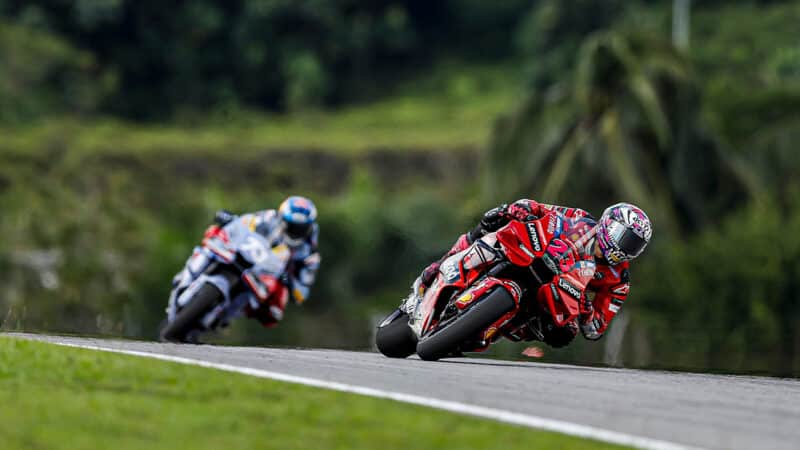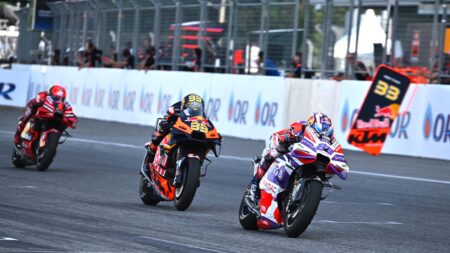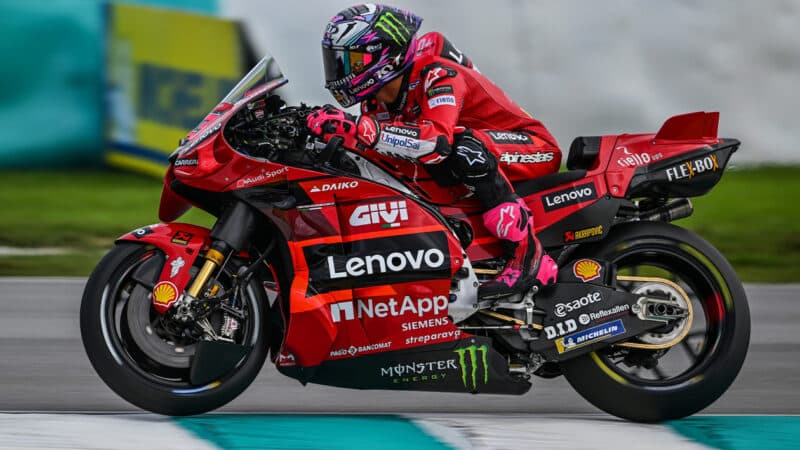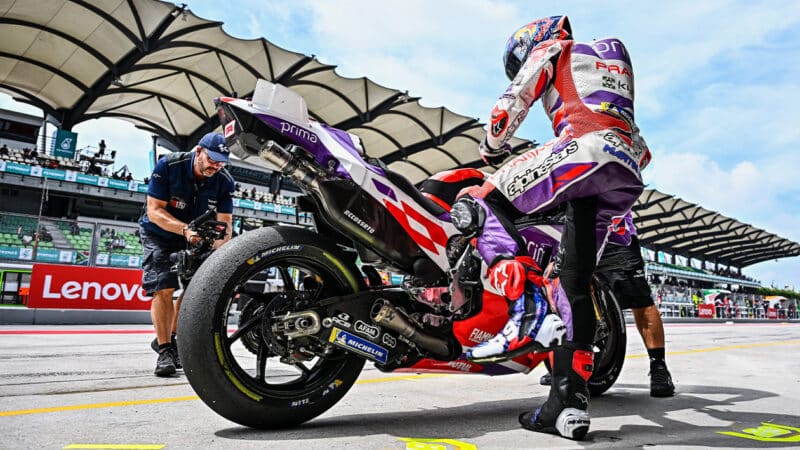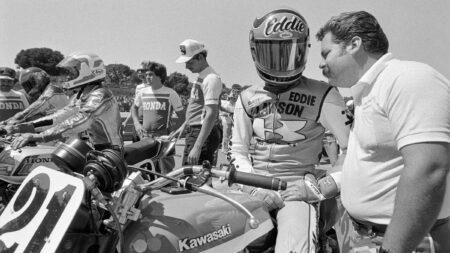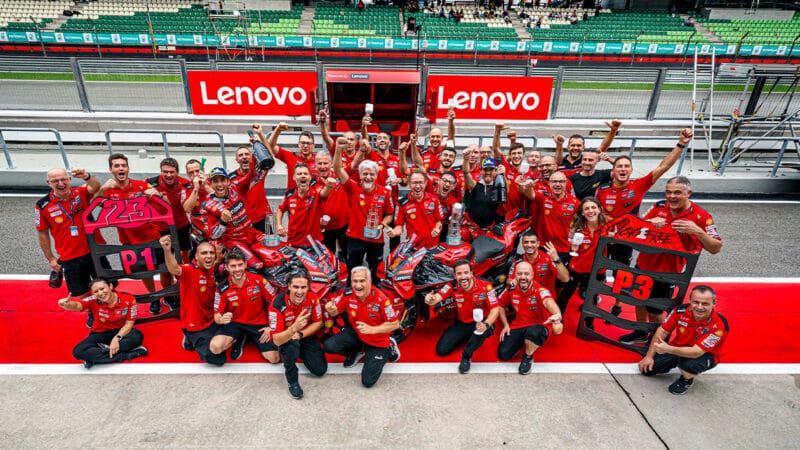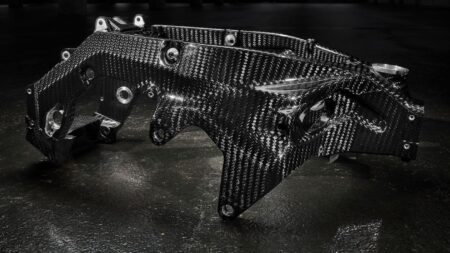How did a rider who had missed half the season through injury (Bastianini broke a shoulder when he was taken out by Luca Marini in the season-opening Portimao sprint and mangled a hand when he caused the first-corner Catalan GP pile-up) and whose previous best finish was a distant eighth at Sachsenring destroy his rivals on Sunday?
Last year Bastianini won four races on a second-hand Gresini GP22, which perfectly suited his riding technique – super-fast corner entries. The GP23 is different and he couldn’t attack corners with the same ferocity, probably because the latest engine has different crankshaft inertia, so it creates different negative torque for different engine-braking, so he wasn’t able to get the bike stopped fast enough to set up his lightning-fast entries.
All that changed at Sepang. Ducati engineers finally created a new engine-braking software/hardware strategy that suited his technique and convinced him to switch from a conventional foot rear brake to a thumb-operated brake, which allowed him to perfectly blend engine-braking with rider-braking.
Rear-end braking has never been more important in MotoGP, because Michelin’s super-grippy rear slick is so effective at stopping the bike, in a straight line and as the rider heads into the apex.
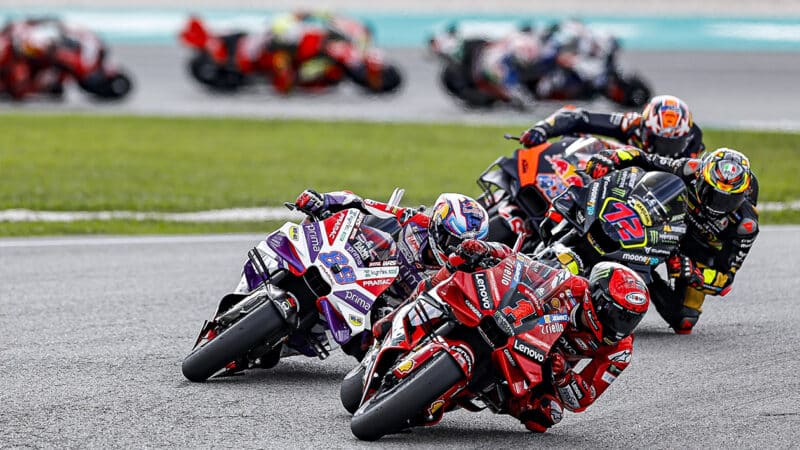
Martin attacked title rival Bagnaia a couple of times but had to give up when his front tyre overheated
Ducati
Most astonishing is the fact that it took the 25-year-old less than two hours of riding to reprogramme his brain from swapping his right foot for his left thumb. This is quite a feat when you’re trying to slow down from around 200mph and have spent your life relying on your right foot.
On Sunday afternoon Bastianini never let anyone even get close enough to attack him. “The change to the engine-brake and using the thumb brake helps me so much – before I was losing too much time into the corners,” he said.
He crossed the finish line for his first victory since Aragon last September, 1.5 seconds ahead of Alex Márquez, who had his best weekend yet, first in sprint and second in the GP.
But what of the championship duel?
Neither points leader Pecco Bagnaia nor sole title-rival Jorge Martin were in the hunt on Sunday. They had no answer to the blinding speed of Bastianini and the younger Márquez, instead engaging in their own duel for the final place on the podium. Briefly at least.
Martin led into the first corner, hoping to repeat his stunning Thai GP win, but he ran wide and dropped to fifth. That compromised his entire race.
While Bastianini and Márquez disappeared out front, Martin attacked Bagnaia. He twice got ahead but the world champion had his elbows out again and immediately counter-attacked. And that was that: Martin’s front tyre overheated – he was in Bagnaia’s roasting slipstream and track temperature was over 50 degrees – and he had to wave the white flag.
This is one reason the race was so spread out – no one can get close to anyone else without burning their front tyre.
“After six laps I was crashing in all the corners,” he said. “It was really difficult and frustrating because I couldn’t push all the race.”
Which brings us to the point that none of us really wants to talk about, but is currently the most decisive factor in MotoGP, so we must talk about it, if we are to understand what’s going on.
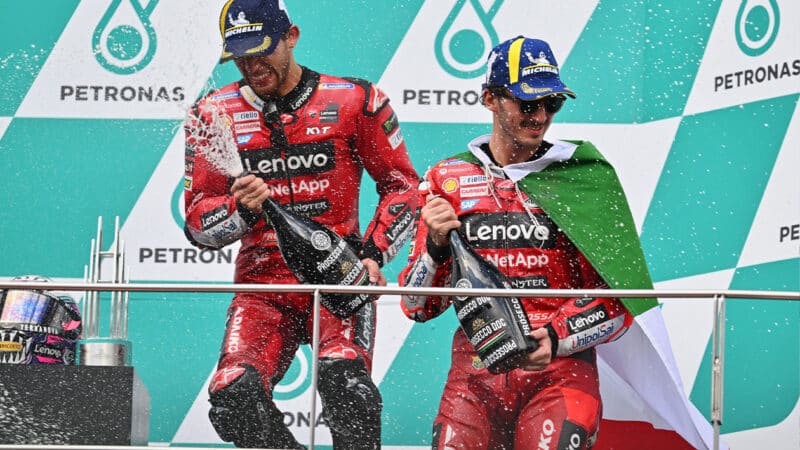
Bastianini took a few points off Bagnaia – but no one seemed too worried because the Beast was back on top
Michelin
Staying above MotoGP’s new 1.88 bar/27.3psi minimum tyre pressure is very difficult, especially in the hotter races, like Sepang, without compromising performance. The rule requires riders to start races with a higher pressure than they’d like, to prevent them running under pressure and getting penalised. And once tyre pressure increases too much, the tyre loses grip.
According to which rider or engineer you speak with, the rule is either “ridiculous”, “a nightmare”, “impossible” or “disgusting”. In almost four decades of covering MotoGP I’ve never heard so many people complain so much about a rule, which suggests that something is very, very wrong and that something needs to be done about it. Fast.
“I hate this rule and it’s going to ruin this championship,” said Aprilia’s Aleix Espargaró after crashing out of the GP.
“Every single meeting we only talk about this but they say there’s no chance to change this rule”
So why don’t the riders get together and do something about it?
“We do this every single weekend,” Espargaró added. “We speak to Michelin, to Piero [Taramasso, Michelin’s motorcycle racing chief], to Carlos [Ezpeleta, Dorna chief sporting officer], to Carmelo [Ezpeleta, Dorna CEO] and every single meeting we only talk about this. I have full confidence in Piero, but they say there’s no chance to change this rule. But I’ve been in MotoGP for 14 years and I’ve never seen a problem with a front tyre [disintegrating].”
In fact there was some good news regarding the tyre rule at Sepang. Two weeks earlier at Buriram, Martin had got a warning for running under pressure for more than 50% of the race. According to the regulations his next offence would give him a three-second penalty.
This basically gave Bagnaia a huge advantage going into the last three weekends – Sepang, Losail and Valencia – because he hadn’t yet got a warning, so he could run under pressure at one of those events to get more front grip than Martin, without receiving a penalty.

Alex Márquez had amazing speed and rode his best MotoGP weekend: sprint victor and GP runner-up
Dorna/MotoGP
“Being under the limit for all the race you have a great advantage in terms of braking and entry,” explained Bagnaia on the eve of the Malaysian GP. “Maybe in this race it could be good to use this jolly [Italian for joker], but I think it could be better to have that advantage in Qatar, where the night race is cold and the humidity can be quite high.”
But the best-laid plans of mice and men…
One hour after Sunday’s race an FIM stewards sanction sheet was delivered to the factory Ducati garage: Bagnaia had been under pressure and had got his warning.
The reason? In Saturday’s sprint he struggled to third place behind Márquez and Martin because his Ducati was pumping so badly out of corners. But this wasn’t a rear-end problem. It was created by his front tyre running over pressure, hence the reduction for Sunday.
